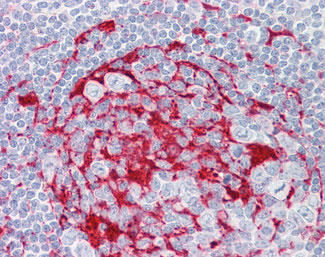LRAT Antibody (aa111-160)
Rabbit Polyclonal Antibody
- SPECIFICATION
- CITATIONS
- PROTOCOLS
- BACKGROUND

Application
| WB, IHC-P, IF, E |
|---|---|
| Primary Accession | O95237 |
| Reactivity | Human, Mouse, Rat |
| Host | Rabbit |
| Clonality | Polyclonal |
| Calculated MW | 26kDa |
| Dilution | ELISA (1:10000), IF (1:100-1:500), IHC-P (5 µg/ml), WB (1:500-1:1000) , |
| Gene ID | 9227 |
|---|---|
| Other Names | Lecithin retinol acyltransferase, 2.3.1.135, Phosphatidylcholine--retinol O-acyltransferase, LRAT |
| Target/Specificity | LRAT Antibody detects endogenous levels of total LRAT protein. |
| Reconstitution & Storage | Store at -20°C for up to one year. |
| Precautions | LRAT Antibody (aa111-160) is for research use only and not for use in diagnostic or therapeutic procedures. |
| Name | LRAT (HGNC:6685) |
|---|---|
| Function | Transfers the acyl group from the sn-1 position of phosphatidylcholine to all-trans retinol, producing all-trans retinyl esters (PubMed:9920938). Retinyl esters are storage forms of vitamin A (Probable). LRAT plays a critical role in vision (Probable). It provides the all-trans retinyl ester substrates for the isomerohydrolase which processes the esters into 11-cis-retinol in the retinal pigment epithelium; due to a membrane-associated alcohol dehydrogenase, 11 cis-retinol is oxidized and converted into 11-cis- retinaldehyde which is the chromophore for rhodopsin and the cone photopigments (Probable). Required for the survival of cone photoreceptors and correct rod photoreceptor cell morphology (By similarity). |
| Cellular Location | Endoplasmic reticulum membrane; Single-pass membrane protein. Rough endoplasmic reticulum. Endosome, multivesicular body. Cytoplasm, perinuclear region. Note=Present in the rough endoplasmic reticulum and multivesicular body in hepatic stellate cells. Present in the rough endoplasmic reticulum and perinuclear region in endothelial cells (By similarity). |
| Tissue Location | Hepatic stellate cells and endothelial cells (at protein level). Found at high levels in testis and liver, followed by retinal pigment epithelium, small intestine, prostate, pancreas and colon. Low expression observed in brain. In fetal tissues, expressed in retinal pigment epithelium and liver, and barely in the brain |
| Volume | Array |

Thousands of laboratories across the world have published research that depended on the performance of antibodies from Abcepta to advance their research. Check out links to articles that cite our products in major peer-reviewed journals, organized by research category.
info@abcepta.com, and receive a free "I Love Antibodies" mug.
Provided below are standard protocols that you may find useful for product applications.
Background
Transfers the acyl group from the sn-1 position of phosphatidylcholine to all-trans retinol, producing all-trans retinyl esters. Retinyl esters are storage forms of vitamin A. LRAT plays a critical role in vision. It provides the all-trans retinyl ester substrates for the isomerohydrolase which processes the esters into 11-cis-retinol in the retinal pigment epithelium; due to a membrane-associated alcohol dehydrogenase, 11 cis-retinol is oxidized and converted into 11-cis-retinaldehyde which is the chromophore for rhodopsin and the cone photopigments.
References
Ruiz A.,et al.J. Biol. Chem. 274:3834-3841(1999).
Zolfaghari R.,et al.Gene 341:181-188(2004).
Ota T.,et al.Nat. Genet. 36:40-45(2004).
Mural R.J.,et al.Submitted (SEP-2005) to the EMBL/GenBank/DDBJ databases.
Mondal M.S.,et al.Biochemistry 39:5215-5220(2000).
If you have used an Abcepta product and would like to share how it has performed, please click on the "Submit Review" button and provide the requested information. Our staff will examine and post your review and contact you if needed.
If you have any additional inquiries please email technical services at tech@abcepta.com.













 Foundational characteristics of cancer include proliferation, angiogenesis, migration, evasion of apoptosis, and cellular immortality. Find key markers for these cellular processes and antibodies to detect them.
Foundational characteristics of cancer include proliferation, angiogenesis, migration, evasion of apoptosis, and cellular immortality. Find key markers for these cellular processes and antibodies to detect them. The SUMOplot™ Analysis Program predicts and scores sumoylation sites in your protein. SUMOylation is a post-translational modification involved in various cellular processes, such as nuclear-cytosolic transport, transcriptional regulation, apoptosis, protein stability, response to stress, and progression through the cell cycle.
The SUMOplot™ Analysis Program predicts and scores sumoylation sites in your protein. SUMOylation is a post-translational modification involved in various cellular processes, such as nuclear-cytosolic transport, transcriptional regulation, apoptosis, protein stability, response to stress, and progression through the cell cycle. The Autophagy Receptor Motif Plotter predicts and scores autophagy receptor binding sites in your protein. Identifying proteins connected to this pathway is critical to understanding the role of autophagy in physiological as well as pathological processes such as development, differentiation, neurodegenerative diseases, stress, infection, and cancer.
The Autophagy Receptor Motif Plotter predicts and scores autophagy receptor binding sites in your protein. Identifying proteins connected to this pathway is critical to understanding the role of autophagy in physiological as well as pathological processes such as development, differentiation, neurodegenerative diseases, stress, infection, and cancer.




